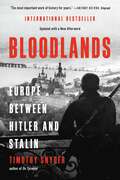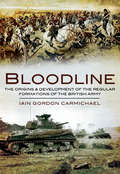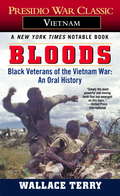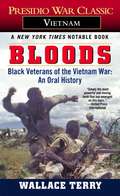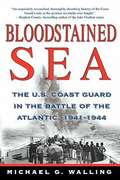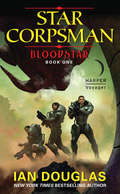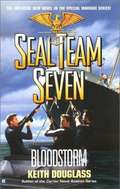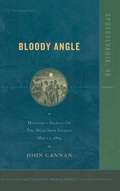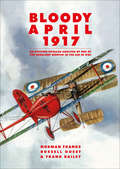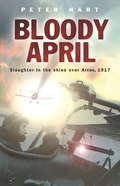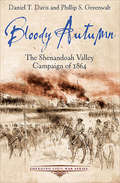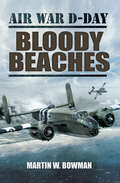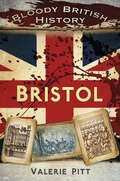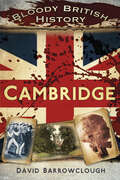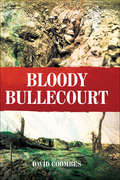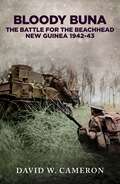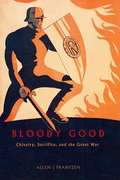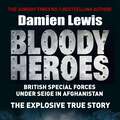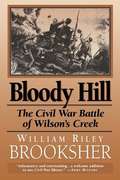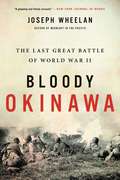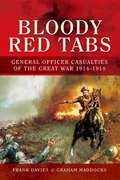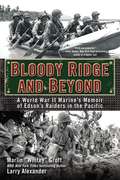- Table View
- List View
Bloodlands: Europe Between Hitler and Stalin
by Timothy SnyderAmericans think of World War II as "The Good War. ” But before it even began, America’s ally Stalin had shot and starved millions of his own citizens; he would continue to do so throughout the war. American soldiers liberated concentration camps, but they never reached the death factories, killing fields, and starvation sites in the East where Hitler and Stalin murdered civilians on a massive scale. In twelve years, in deliberate killing policies unrelated to combat, the Nazi and Soviet regimes killed fourteen million people in a zone of death between Berlin and Moscow. At war’s end, these bloodlands fell behind the iron curtain, leaving their history in darkness. In Bloodlands, acclaimed historian Timothy Snyder offers a groundbreaking investigation of the place where Europeans were murdered by the millions, providing a fresh account of the atrocities perpetrated by the two regimes. Assiduously researched, deeply humane, and utterly definitive, Bloodlands is required reading for anyone seeking to understand the central tragedy of modern history.
Bloodline: The Origins & Development of the Regular Formations of the British Army
by Iain GordonA guide to the history of each of the British Army’s regular formations, from their origins to their development over time.Using easy-to-follow, family-tree type tables, Bloodline shows the origins and development of every regular formation in the British Army including the latest amalgamations and changes brought about within the “Future Army Structure.”The charts illustrate clearly how, in some cases, up to twenty-five original regiments of the line have, over the centuries, by successive disbandments and amalgamations, been reduced to a single regiment in today’s superb but shamefully overstretched army.The Battle Honours of each post-Cardwell constituent are recorded separately so the progress of each of the original regiments, and the theatres in which it was involved, may be examined individually. The pedigrees and Honours of disbanded units are also recorded so their contribution will not be lost to posterity. A chronological summary of Battle honours provides an overview of the British Army’s campaigns over the past 300 years and notes on the origins of each formation place its original purpose within the political and historical perspective of the time.A robust editorial platform throughout applauds the Army as “the Nation’s most dependable and trustworthy institution” and castigates government neglect and public indifference for the unnecessary “blood and sacrifices” which successive generations of soldiers have had to make as a result of inadequate investment and preparation.Bloodline is a splendid record of achievement and will provide an invaluable work of reference for anyone who has dealings with, or simply an interest in or affection for, the British Army.Praise for Bloodlines“I know of no other resource that contains such a wealth of information about the History of the Regiments of the British Army. This will be a very useful addition to my shelf of military reference books.” —Daly History Blog “If you conduct research into the main elements of the British Army then this is an invaluable guide as to their lineage, hereditary and modern counterparts. The author has produced an outstanding reference text in one easy to follow volume. He has done great service to aiding researchers with this publication. In one excellent volume he has listed the principal elements of the Army and their histories. This concise volume deserves space on any serious researcher’s shelf.” —Military Archive Research
Bloods
by Wallace Terry"Simply the most powerful and moving book that has emerged on this topic." UNITED PRESS INTERNATIONALThe national bestseller that tells the truth of about Vietnam from the black soldiers' perspective. An oral history unlike any other, BLOODS features twenty black men who tell the story of how members of their race were sent off in disproportionate numbers and the special test of patriotism they faced. Told in voices no reader will soon forget, BLOODS is a must-read for anyone who wants to put the Vietnam experience in historical, cultural, and political perspective.Cited by THE NEW YORK TIMES as One of the Notable Books of the Year"Superb."TIME
Bloods: An Oral History of the Vietnam War by Black Veterans
by Wallace Terry"Simply the most powerful and moving book that has emerged on this topic." UNITED PRESS INTERNATIONAL. The national bestseller that tells the truth of about Vietnam from the black soldiers' perspective.
Bloodstained Sea: The U.S. Coast Guard in the Battle of the Atlantic, 1941-1944
by Michael G. WallingThe U.S. Coast Guard, typically pictured as gleaming white vessels dispatched to save mariners in distress, played a vital role during World War II. Called upon in desperate times, the Coast Guard steamed into action and plied the unforgiving waters of the North Atlantic protecting convoys carrying much needed supplies, hunting German U-boats, pulling survivors of destroyed ships from the sea, and helping to ensure that the Atlantic remained in Allied control. The bloody skirmishes, numerous sinkings, and horrific death toll tallied in the Atlantic between 1939 and 1945 became known as the Battle of the Atlantic. Stretching from above the Arctic Circle south to the Cape of Good Hope and west from the coast of England into the Caribbean and down the coast of South America, the Battle of the Atlantic was fought continuously for 2,075 days. Whoever won the battle would control the vast sea-lanes necessary to win the war in Europe. Ships are the only way of moving large amounts of men and material across an ocean, and the United Kingdom, an island nation, needed to import virtually everything to sustain her people. Also, starting in 1941, the large amount of supplies the Soviet Union needed to repel German forces had to be shipped either north from England to Murmansk or around the Cape of Good Hope, then north into the Persian Gulf and overland to Russia. The same route was used to supply British and British Commonwealth troops in Egypt, except that these ships went up the Red Sea and through the Suez Canal.
Bloodstar
by Ian Douglas"In the 23rd century, war is still hell... Navy Corpsman Elliot Carlyle joined up to save lives and see the universe. Now he and Bravo Company's Black Wizards of the interstellar Fleet Marine Force are en route to Bloodworld-- a hellish, volatile rock colonized by the fanatical Salvationists who desired an inhospitable world where they could suffer for humanity's sins. Their penance could prove fatal...
Bloodstar
by Ian DouglasIn the 23rd Century, war is still hell . . . Navy Corpsman Elliot Carlyle joined up to save lives and see the universe. Now he and Bravo Company's Black Wizards of the interstellar Fleet Marine Force are en route to Bloodworld--a hellish, volatile rock colonized by the fanatical Salvationists who desired an inhospitable world where they could suffer for humanity's sins. Their penance could prove fatal--for the Qesh, a strange alien race detected but still mysterious for six decades, have made violent first contact.Suddenly countless lives depend upon Bravo Company--perhaps even the fate of homeworld Earth itself--as the Marines prepare to confront a vast force of powerful, inscrutable enemies. And one dedicated medic, singled out by an extraordinary act of valor, will find himself with an astounding opportunity to alter the universe forever . . .
Bloodstorm (Seal Team Seven, #13)
by Keith DouglassSix Russian Satan intercontinental ballistic missiles have disappeared from the Ukraine--only to resurface in Libya. Now, Colonel Muammar al-Qaddafi has sixty nuclear warheads to help him regain power in the Middle East--and he's just set one off in a small city in Chad where thirty thousand civilians once lived. Now, Lieutenant Commander Blake Murdock and his elite SEAL Team must embark on a covert operation to find and dismantle the rest of Libya's arsenal--before all of Africa is engulfed in nuclear fire.
Bloody Angle: Hancock's Assault on the Mule Shoe Salient, May 12, 1864
by John CannonDawn was breaking in the hard rain on the morning of 12 May 1864. It was then that tired Union soldiers under General Hancock's command launched a daring assault on the apex of heavily defended Confederate line outside Spotsylvania.
Bloody April 1917: An Exciting Detailed Analysis of One of the Deadliest Months in the Air in WWI
by Frank Bailey Norman Franks Russell Guest&“Nowhere will you find such an exhaustive book on the day-to-day events of the aerial war over the Western front in April 1917.&” —A Wargamers Needful Things Even those people who know little of WWI&’s air war will have heard of Bloody April. After more than eighteen months of deadly stalemate on the Western Front, by April 1917 the British and French were again about to launch yet another land offensive, this time on the Arras Front. This would be the first opportunity to launch a major offensive since the winter and would require enormous support from the Royal Flying Corps and French Air Force in, hopefully, improved weather. However, the air offensive was to be countered fiercely by the new German Jagstaffeln—Jastas—that had been the brainchild of Oswald Boelcke in 1916. By the spring of 1917, the first Jasta pilots, with new improved fighters—the nimble Albatros DIIIs—were just itching to get to grips with their opponents over the Western Front. What followed was a near massacre of British and French aircraft and crews, which made April the worst month for flying casualties the war had yet seen. Here is a day-by-day, blow-by-blow account of these losses, profusely illustrated with original photographs and expertly told.&“A highly detailed work that is meticulously peppered with eyewitness testimony, quality research, original photographs and accessible statistics. It also recreates the period for the reader and has a keen eye for accuracy and as a reference work it comes highly recommended.&” —History of War &“One of the most comprehensive overviews of early warfare ever published.&” —Flypast
Bloody April: Slaughter In The Skies Over Arras, 1917
by Peter HartThe story of the decimation of the Royal Flying Corps over Arras in 1917As the Allies embarked upon the Battle of Arras, they desperately needed accurate aerial reconnaissance photographs. But by this point the Royal Flying Club were flying obsolete planes. The new German Albatros scouts massively outclassed them in every respect: speed, armament, ability to withstand punishment and manoeuverability. Many of the RFC's pilots were straight out of flying school - as they took to the air they were sitting targets for the experienced German aces. Over the course of 'Bloody April' the RFC suffered casualties of over a third. The average life expectancy of a new subaltern on the front line dropped to just eleven days. And yet they carried on flying, day after day, in the knowledge that, in the eyes of their commanders at least, their own lives meant nothing compared to the photographs they brought back, which could save tens of thousands of soldiers on the ground. In this book Peter Hart tells the story of the air war over Arras, using the voices of the men who were actually there.
Bloody April: Slaughter in the Skies over Arras, 1917
by Peter HartThe story of the decimation of the Royal Flying Corps over Arras in 1917As the Allies embarked upon the Battle of Arras, they desperately needed accurate aerial reconnaissance photographs. But by this point the Royal Flying Club were flying obsolete planes. The new German Albatros scouts massively outclassed them in every respect: speed, armament, ability to withstand punishment and manoeuverability. Many of the RFC's pilots were straight out of flying school - as they took to the air they were sitting targets for the experienced German aces. Over the course of 'Bloody April' the RFC suffered casualties of over a third. The average life expectancy of a new subaltern on the front line dropped to just eleven days. And yet they carried on flying, day after day, in the knowledge that, in the eyes of their commanders at least, their own lives meant nothing compared to the photographs they brought back, which could save tens of thousands of soldiers on the ground. In this book Peter Hart tells the story of the air war over Arras, using the voices of the men who were actually there.
Bloody Autumn: The Shenandoah Valley Campaign of 1864 (Emerging Civil War Series)
by Daniel T. Davis Philip S. GreenwaltAn “essential addition to serious students’ libraries” detailing the historic military offensive that helped sway the outcome of the American Civil War (Civil War News). In the late summer of 1864, Union General-in-Chief Ulysses S. Grant set one absolutely unconditional goal: to sweep Virginia’s Shenandoah Valley “clean and clear.” His man for the job: Maj. Gen. “Little Phil” Sheridan—a temperamental Irishman who’d proven himself just the kind of scrapper Grant loved. The valley had already played a major part in the war for the Confederacy as both the location of major early victories against Union attacks, and as the route used by the Army of Northern Virginia for its invasion of the North, culminating in the battle of Gettysburg. But when Sheridan returned to the Valley in 1864, the stakes heightened dramatically. For the North, the fragile momentum its war effort had gained by the capture of Atlanta would quickly evaporate. For Abraham Lincoln, defeat in the Valley could mean defeat in the upcoming election. And for the South, its very sovereignty lay on the line. Here, historians Davis and Greenwalt “weave an excellent summary of the campaign that will serve to introduce those new to the Civil War to the events of that ‘Bloody Autumn’ and will serve as a ready refresher for veteran stompers who are heading out to visit those storied fields of conflict” (Scott C. Patchan, author of The Last Battle of Winchester).
Bloody Beaches: Bloody Beaches (Air War D-Day #4)
by Martin W. BowmanThis fourth volume of a comprehensive five part work on D-Day covers every aspect of aerial operations on and behind the beaches at 'Omaha' and 'Utah' beaches on 6 June 1944. It might be imagined that the passing years would blunt the outlines of the experience but the D-Day veterans do not forget. Their accounts convey the chaos, terror and hysteria as the first salvos of German fire clanged off the landing craft, in language that is all the more powerful for its terseness and simplicity.The landings at 'Omaha' which were vital to connect the US troops at 'Utah' Beach with the British and Canadian beaches to the east were an unmitigated disaster with an estimated 3,000 killed, wounded and missing. The highest number of casualties of all the beaches, they were the greatest American losses in one battle since the Battle of Antietam Creek in the American Civil War in September 1862. The situation on the beach was chaotic as troops were pinned down by enemy fire and had to take cover behind mined beach defenses. As things progressed, it was an accumulation of individual acts of self-sacrifice and gallantry which opened up an exit and a seaborne bombardment by the task force saw tenuous footholds finally gained by early afternoon. In stark contrast to Omaha, an almost textbook landing was made at Utah; the air bombardment was effective and a strong current actually landed the 4th Infantry Division 2,000 yards south of their intended target where the beach was less heavily defended. This account analyses each aspect of the aerial operation, noting how events on the ground and in the sea impacted upon pilots endeavors in the skies. Evocative images supplement the text effectively to create a real sense of what it was like for the pilots of D-Day, the individuals who made such a contribution to the Allied war effort in the Second World War.
Bloody British History: Bristol (Bloody British History)
by Valerie PittCorpses in the street! The Black Death decimates Bristol. A stomach full of arsenic! Poisoned puddings and merry murderers. 'Take that you brute!’ Suffragettes attack Winston Churchill. Bombs drop on Bristol! Blackouts and the Blitz. Bristol has one of the bloodiest histories on record. One of Britain’s key ports, it suffered devastating attacks from every possible invader, from Saxon fleets all the way through to the Nazi bombers of the Second World War. Meanwhile, adventurers, smugglers and pirates sailed from its docks, and more than half a million souls sailed in chains, victims of Bristol’s vile slave trade ended only by the Herculean efforts of the abolitionists – Bristol folk amongst them. Containing hundreds of years of history and amazing true stories of eccentric residents such as con-woman ‘Princess Caraboo’, who ended her days as a Bristol leech-seller, no Bristol bookshelf is complete without this book.
Bloody British History: Cambridge (Bloody British History)
by David BarrowcloughDeath to students: The weird origin of the University! A plague on both your parishes: Black Death in Cambridge’s streets! Off with his head: The bizarre true story of Oliver Cromwell's travelling skull! Gas! Gas! The secret research team behind WWI's deadliest weapon! The fifth man: The truth about the Cambridge Five, the Soviet spies who studied! Cambridge has some of the most violent history ever recorded. From invading hordes of Vikings, Saxons and Normans to the secret Allied plans of the Second World War, it will thrill, disgust and delight in equal measure!
Bloody Bullecourt
by David CoombesIn April-May 1917 the sleepy hamlet of Bullecourt in Northern France became the focus of two battles involving British and Australian troops. Given the unique place in Australia's military history that both battles occupy, surprisingly little has been written on the AIF's achievements at Bullecourt. Bloody Bullecourt seeks to remedy this gasping omission.The First Battle of Bullecourt marked the Australians' introduction to the latest battlefield weapon—the tank. This much-lauded weapon failed dismally amid enormous casualties. Despite this, two infantry brigades from the 4th Australian Division captured parts of the formidable Hindenberg Line with minimal artillery and tank support, repulsing German counterattacks until forced to withdraw.In the second battle, launched with a preliminary artillery barrage, more Australian divisions were forced into the Bullecourt 'meat-grinder' and casualties scored over 7,000. Once more, soldiers fought hard to capture parts of the enemy line and hold them against savage counterattacks.Bullecourt became a charnel-house for the AIF. Many who had endured he nightmare of Pozires considered Bullecourt far worse. And for what? While Field Marshal Sir Douglas Haig considered its capture 'among the great achievements of the war', the village that cost so many lives held no strategic value whatsoever.
Bloody Buna: The Battle for the Beachhead New Guinea 1942
by David W. CameronWith the Australian troops crossing of the Kumusi River in mid-November, after pushing the Japanese back along the Kokoda Track, the time had come to face the entrenched Japanese at their beachhead at Gona, Sanananda and Buna. The end of the Kokoda Campaign in mid-November 1942 marked a turning point for the Australians, but the fighting was far from over. Within days, the battles for the three Japanese beachheads would commence. These battles where the first combined large-scale operation between Australian and American troops against the Japanese and would prove to be among the fiercest of the Pacific War. At Buna, the final battles to take 'New' and 'Old' air strips by the Australians, along with the ongoing American attacks to take the infamous 'Triangle,' proved to be a brutal and deadly bloodbath for all concerned. Amidst the crocodile-infested swamps and lowland jungle with dozens of Japanese bunkers and pillboxes with supporting artillery, the Australians who fought at all three beachheads faced an unprecedented toll, suffering more killed or wounded than in any other campaign of the Pacific war. In the face of relentless combat, the Allied forces at Buna suffered staggering casualties, with 2817 men lost at Buna. The American 32nd Division sustained 1954 casualties, including 353 killed (18%), 1508 wounded, and 93 missing amounting to around 40 per cent casualties over a six week period. The Australian 18th Infantry Brigade and supporting elements suffered 863 casualties, with 267 killed (31%), 557 wounded, and 39 missing amounting to around 60 per cent casualties over just three weeks of fighting. As the battle raged on, the Japanese suffered significant losses, with a minimum of 1390 men killed at Buna. The true number of their dead, lost in history, is likely much higher, with conservative estimates suggesting around 3000 fatalities. &“Bloody Buna" sheds light on the untold sacrifices and heroism displayed by the Australian and American troops as they clashed with the Japanese in one of the most vicious chapters of the Pacific War.
Bloody Good: Chivalry, Sacrifice, and the Great War
by Allen J. FrantzenFrantzen shows how such media shaped a chivalry ideal of male sacrifice based on the Passion of Jesus Christ. He demonstrates, for instance, how the wounded body of Christ became the inspiration for heroic male suffering in battle. For some men, the Crucifixion inspired a culture of revenge, one in which Christ's bleeding wounds were venerated as badges of valor and honor.
Bloody Heroes: BRITISH SPECIAL FORCES UNDER SEIGE IN AFGHANISTAN. THE EXPLOSIVE TRUE STORY.
by Damien LewisThe most explosive true war story of the 21st Century.It is the winter of 2001. A terror ship is bound for Britain carrying a horrifying weapon. The British military sends a crack unit of SAS and SBS to assault the vessel before she reaches London.So begins a true story of explosive action as this band of elite warriors pursues the merchants of death from the high seas to the harsh wildlands of Afghanistan. The hunt culminates in the single greatest battle of the Afghan war, the brutal and bloody siege of an ancient mud-walled fortress crammed full of hundreds of Al-Qaeda and Taliban.Fighting against impossible odds and bitter betrayal, our handful of crack fighters battle to rescue their fellow soldiers trapped by a murderous, fanatical enemy.'The most dramatic story of a secret wartime mission you will ever read' News of the World'The author has been given unprecedented access' Zoo'Gripping' Eye Spy(P)2023 Quercus Editions Limited
Bloody Heroes: The Explosive True Story of a Band of Secret Warriors in Afghanistan
by Damien LewisBritish and American special forces battle terrorists in this &“gripping&” account spanning a thwarted attack on London to the Battle of Qala-i-Janghi (Duncan Falconer, author of First Into Action). Two months after 9/11, the British military was braced to foil any terrorist attacks against the UK. When British intelligence uncovered such a plot—a cargo ship bound for the English Channel carrying a suspect deadly chemical weapon—they amassed an elite team of SBS (Special Boat Services) and SAS (Special Air Service) soldiers to assault the vessel before she could reach London. It was a mission that would eventually take a crack band of British and American warriors into the greatest battle of the Afghan Civil War—the massive bloody uprising by hundreds of Al Qaeda and Taliban prisoners within the walls of the ancient fortress of Qala-i-Janghi, and the ensuing eight-day siege. When the fighting ended, over five hundred of the enemy lay dead, more terrorists killed than in any other single battle in Afghanistan. As always, &“Damien Lewis takes his readers into the heart of clandestine battles as no one else seems able&” (Frederick Forsyth, #1 New York Times–bestselling author of The Day of the Jackal).
Bloody Hill: the Civil War Battle of Wilson's Creek
by William Riley BrooksherThis is a well-documented and easy-to-follow discussion of the first major battle in the American West in the Civil War. The battle took place in 1861, and resulted in a loss for the northern forces. This book also contains a well-presented analysis of the political and economic factors which lead to the war being fought.
Bloody Okinawa: The Last Great Battle of World War II
by Joseph WheelanA stirring narrative of World War II's final major battle--the Pacific war's largest, bloodiest, most savagely fought campaign--the last of its kind. On Easter Sunday, April 1, 1945, more than 184,000 US troops began landing on the only Japanese home soil invaded during the Pacific war. Just 350 miles from mainland Japan, Okinawa was to serve as a forward base for Japan's invasion in the fall of 1945. Nearly 140,000 Japanese and auxiliary soldiers fought with suicidal tenacity from hollowed-out, fortified hills and ridges. Under constant fire and in the rain and mud, the Americans battered the defenders with artillery, aerial bombing, naval gunfire, and every infantry tool. Waves of Japanese kamikaze and conventional warplanes sank 36 warships, damaged 368 others, and killed nearly 5,000 US seamen. When the slugfest ended after 82 days, more than 125,000 enemy soldiers lay dead--along with 7,500 US ground troops. Tragically, more than 100,000 Okinawa civilians perished while trapped between the armies. The brutal campaign persuaded US leaders to drop the atomic bomb instead of invading Japan. Utilizing accounts by US combatants and Japanese sources, author Joseph Wheelan endows this riveting story of the war's last great battle with a compelling human dimension.
Bloody Red Tabs: General Officer Casualties of the Great War 1914–1918
by Graham Maddocks Frank DaviesLong before that ghastly and quite unnecessary slogging match in the mud which we now call the First World War had dragged to its blood-soaked conclusion the belief that most of the senior officers had spent their time in comfort and safety in chateaux far behind the lines with no idea of the conditions in which the men they commanded were fighting was firmly embedded in the public mind. As the years pass by that belief has, if anything, become more deeply held, gaining strength from plays like Oh! What a Lovely War, itself based on Alan Clark's book The Donkeys.It is the purpose of this book to show not only how the myth was born and grew but how totally at odds it is with the facts. Biographies of over 200 officers who held the rank of Brigadier-General or above who were killed or wounded during the war show how closely involved the men at the top were with the men at the front. Ironically, as the authors point out, this was more than just a waste of blood, for these were the very men whose experience was vital to the successful prosecution of the war. Had they actually stayed in their chateaux, as Lloyd George alleged, they might have done much more to hasten the end of the conflict.This is not only an invaluable work of reference but a tribute to those gallant senior officers who have been so unfairly traduced by many who should have known better.As featured in Essence Magazine.
Bloody Ridge and Beyond
by Larry Alexander Marlin GroftBy a veteran of Lt. Col. Merritt A. Edson's battalion, and author of the Dick Winters biography Biggest Brother and coauthor of A Higher Call On the killing ground that was the island of Guadalcanal, a 2,000-yard-long ridge rose from the jungle canopy. Behind it lay the all-important air base of Henderson Field. And if Henderson Field fell, it would mean the almost certain death or capture of all 12,500 marines on the island . . . But the marines positioned on the ridge were no normal fighters. They were tough, hard-fighting men of the Edson's Raiders; an elite fighting unit within an already elite U.S. Marine Corps. Handpicked for their toughness, and submitted to a rigorous training program to weed out those less fit, they were the Marine Corps's best of the best. For two hellish nights in September 1942, about 840 United States Marines--commanded by Lieutenant Colonel Merritt Austin "Red Mike" Edson--fought one of the most pivotal battles of World War II in the Pacific, clinging desperately to their position on what would soon be known as Bloody Ridge. Wave after wave of attacking Japanese soldiers were repelled by the Raiders, who knew that defeat and retreat were simply not possible options. But in the end, the defenders had prevailed against the odds. Bloody Ridge and Beyond is the story of the 1st Marine Raider Battalion, which showed courage and valor in the face of overwhelming numbers, as told by Marlin Groft, a man who was a member of this incredible fighting force.
